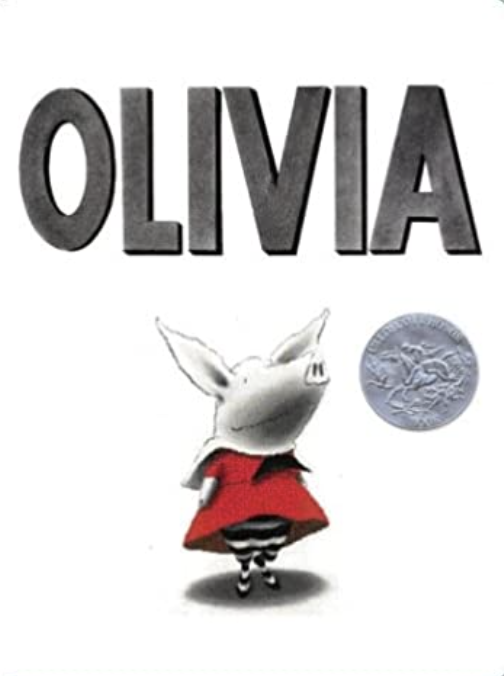Olivia
Book Module Navigation
Summary
Olivia explores philosophical notions of creativity, art, and moderation by following a spunky pig and her busy days.
Ian Falconer’s picture book Olivia features snippets of various days in the life of the piggy protagonist Olivia. Olivia is a confident, strong-minded, and inexhaustible young girl who puts her own creative flair on a wide range of interests from ballet to sandcastles. This beautifully-illustrated book offers the opportunity for a rich discussion of philosophical concepts including value, creativity, art, and curiosity.
Read aloud video by Storytime Bunnies
Guidelines for Philosophical Discussion
Olivia features the irrepressible Olivia, a renaissance pig who is at once dancer, fashion designer, architect, artist, and big sister. Olivia’s imaginative attempts to reproduce a Jackson Pollock painting on her living room wall can lead to an interesting philosophical discussion on the nature of creativity. Some think that being creative means coming up with new and valuable stuff, which immediately raises some interesting questions about value. A modern economist might say that value is price; a Marxist would say that value is socially necessary labor time; someone else might say that a thing is valuable insofar as it is useful for attaining a goal. Some philosophers point out that creativity always occurs in a context; in fact, something is creative in a given field insofar as people who know that field judge it to be both new and valuable, opening up a whole bunch of new questions for discussion: What does it mean for a work of art to be good or valuable, who are the relevant experts that we need to consult, and so on.
Olivia also offers opportunities to discuss art and culture. Ian Falconer’s distinctive style of simple, monochromatic art can make for an engaging back-and-forth on what makes someone an artist; what makes something a piece of artwork. It prompts us to discuss whether we even need to have a definition for art. As Olivia looks up at a Jackson Pollock painting in a museum, she quips that she could probably “do that in five minutes,” which can lead to a discussion on modern art.
From dress-up to sandcastles, Olivia is bright and quick to learn, respectively “feeling [that] it’s important to come prepared” and “becoming pretty good at it.” These are character traits that can kick off a conversation on creativity. Are there rules for creativity, or is art making just unconscious inspiration? If creativity only comes from inside someone or through inspiration, where does the originality spring from, and how does originality arise? If you paint an original masterpiece, where does the uniqueness come from? How can something be created from nothing?
Olivia’s unmatched zest for life and excitement can sometimes be too much for her mother, who disciplines Olivia with a “time out” for her impromptu artwork. It raises broad philosophical questions about consequences and balance regarding curiosity: how can curiosity be good, can it be a bad thing, and if so, why? Olivia is “very good at wearing people out… even wears herself out,” inviting a dialogue on finding the right balance between idleness and action, activity versus reflection in discovery and innovation. For example, is it bad to be lazy? Can you be too hard-working? Are peaceful indolence and quiet reflection equally as important for creativity as industriousness?
Questions for Philosophical Discussion
Creativity
Olivia puts her own creative flair on everything from dress-up to sandcastles to ballet.
- What makes Olivia creative?
- What is creativity? Can you think of some examples from the book and from your own experience?
- Is creativity just coming up with new stuff or is it about putting together new combinations of old things?
- What does Olivia value? Are those things really valuable or only valuable to some people?
- Are there things that you value but someone else might not? Like what?
- Do people decide what is valuable or are some things just valuable all by themselves?
Art and Aesthetics
Olivia doesn’t understand an art piece at the museum, says that she could do the same in about five minutes, and gives painting it a try on her home walls.
- What are some things that you consider to be art? What makes those things artistic?
- What makes someone an artist? Is it just drawing, painting, and coloring?
- Does your art need to be in a museum for you to be an artist? Why or why not?
- Does everyone see the same thing in a work of art or get the same feeling from a work of art? Consider an example.
- Can two people have different opinions on the same thing and both be correct?
Balance and Moderation
Olivia is active and inquisitive, always trying everything and wearing her mother out.
- How can curiosity be good or bad?
- If curiosity can be a bad thing, why?
- Why do people say “curiosity killed the cat”? Is it true?
- Is it good or bad for Olivia to make her mother (or anyone else) tired because Olivia is so active and inquisitive? Why or why not?
- Is it possible to be too active or too curious? Is it possible to work too hard?







